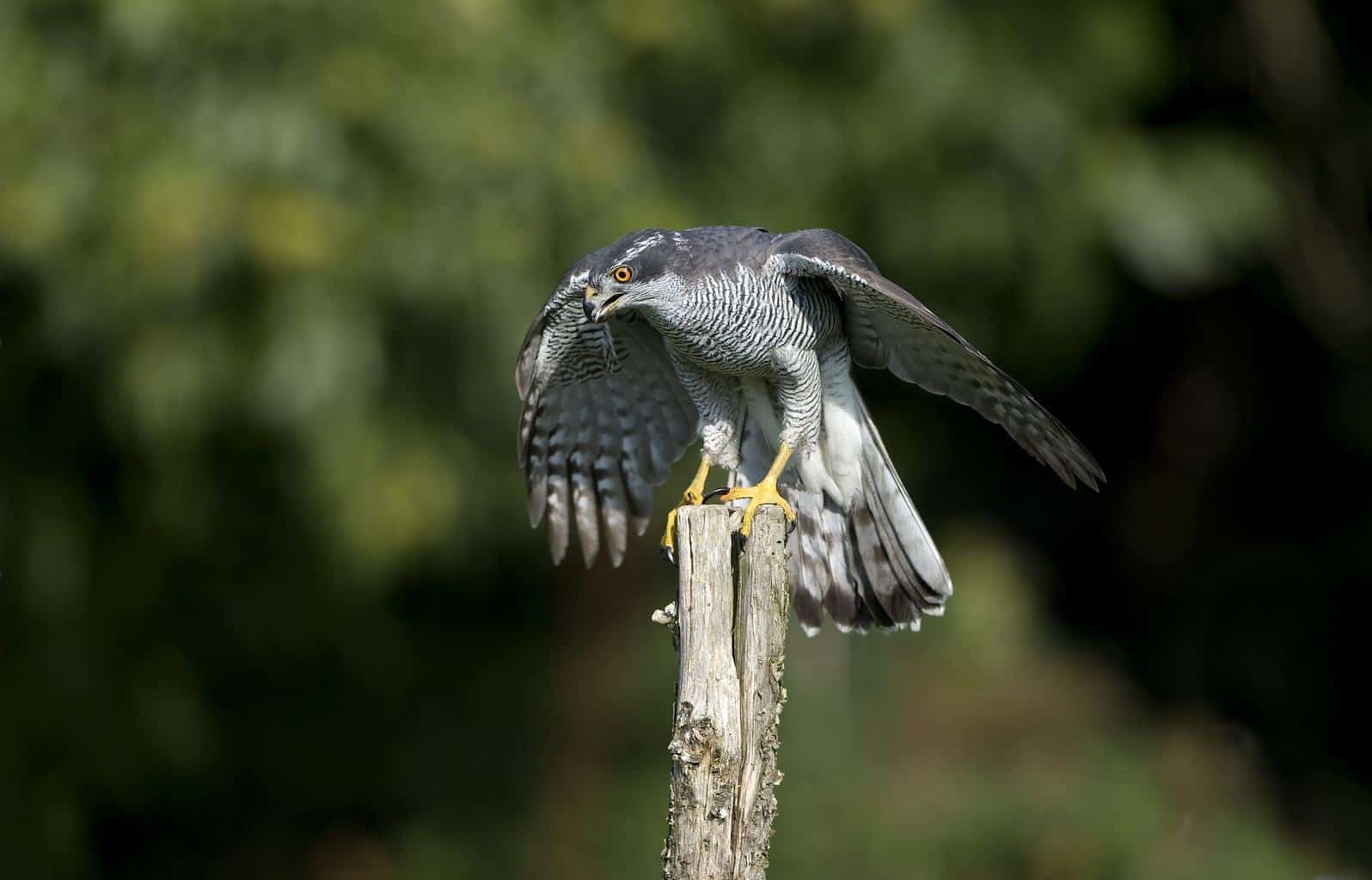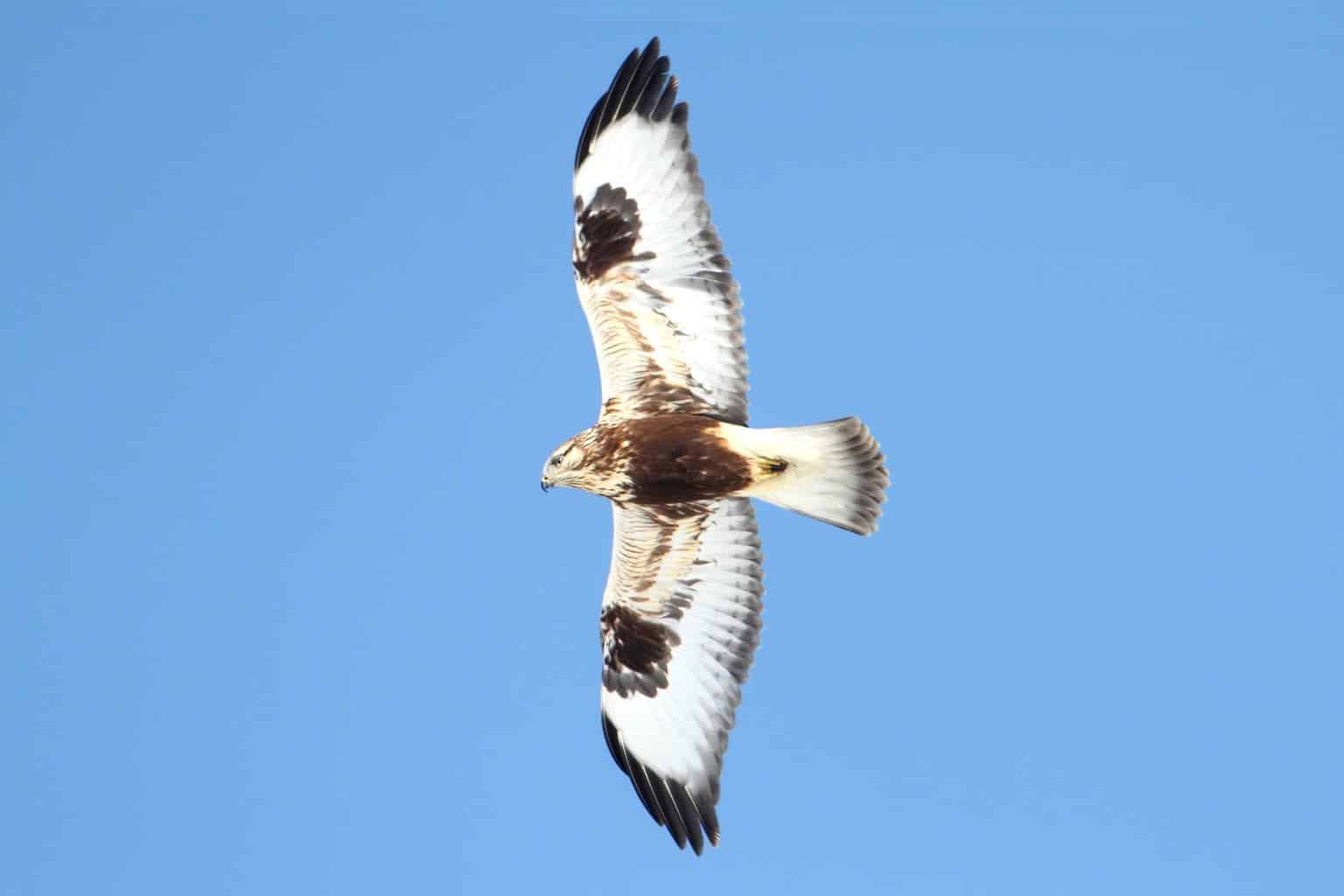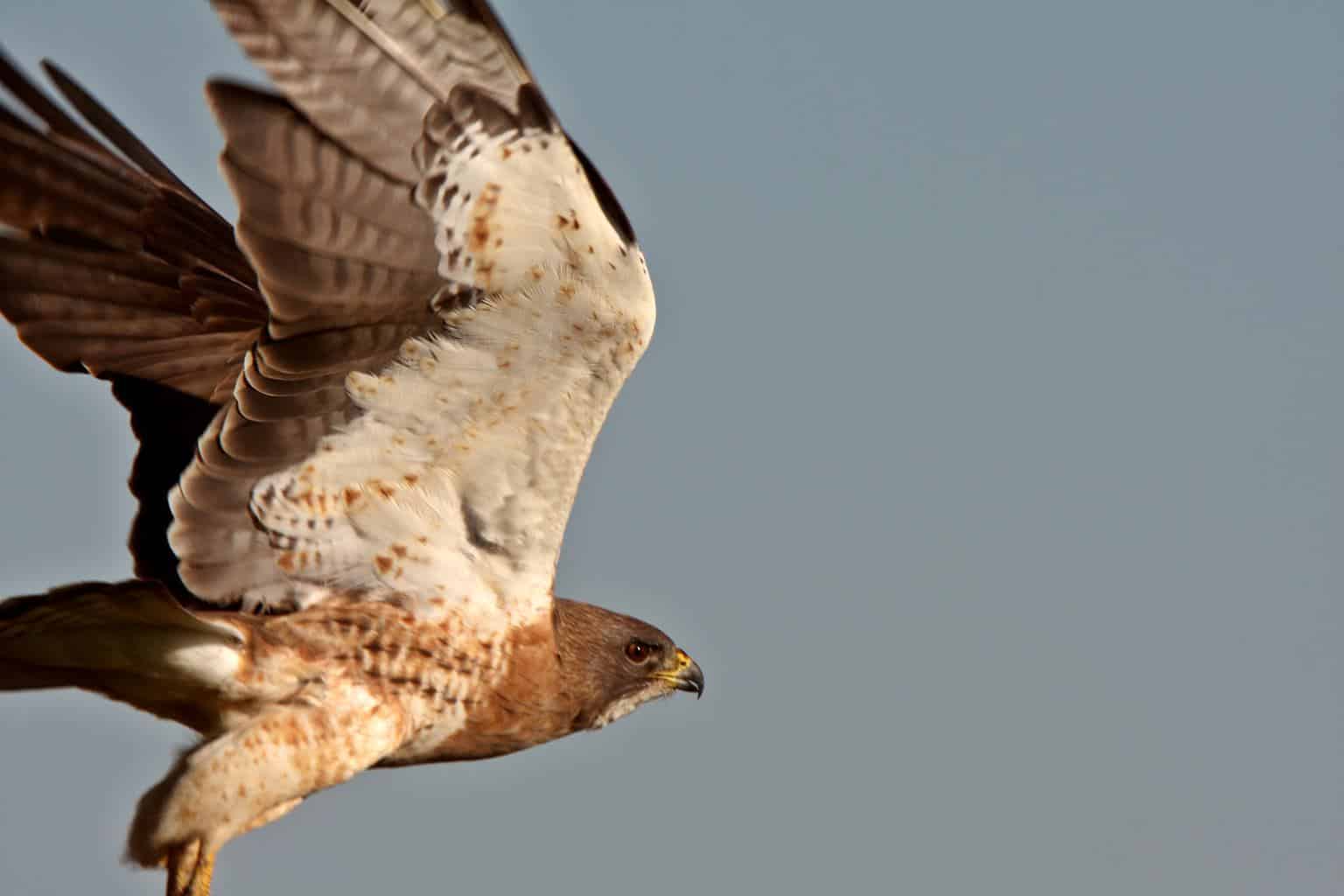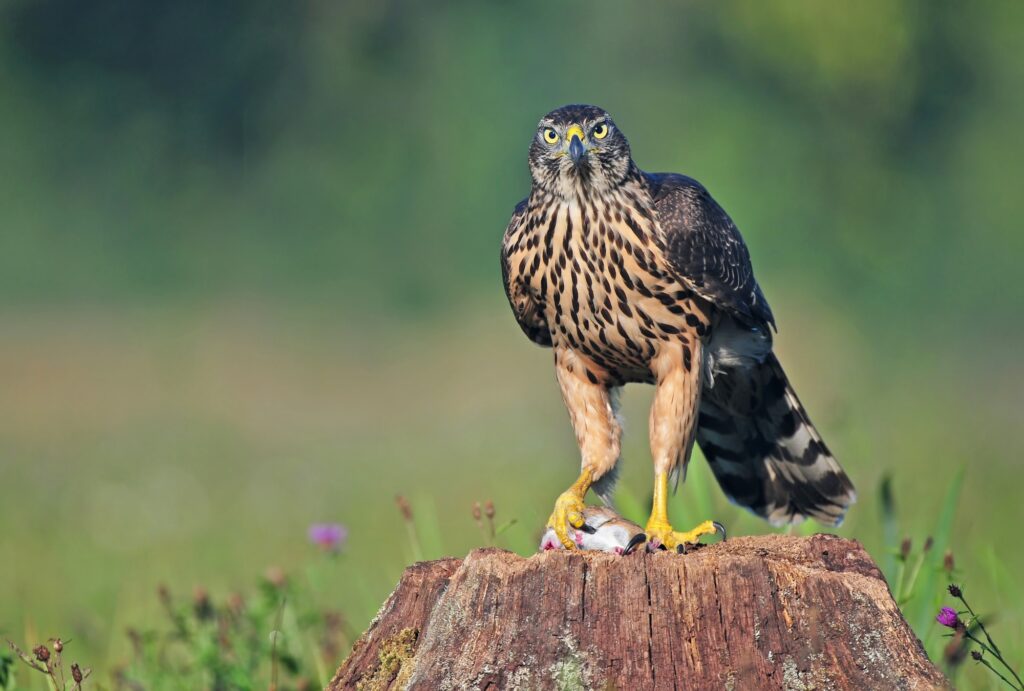Did you know that Rhode Island is home to more than 400 species of birds? The most prominent of these are hawks. Hawks are always fun to watch. They combine beauty with great strength through their beautiful plumage and impressive hunting skills.
Hawks are quite common in Rhode Island. Some of them are frequent backyard visitors, while others like to nest deep in forests away from humans. Some are migratory, and others are year-round residents of the state.
In this post, we’ll give you a good head start in searching for hawks in Rhode Island.
Red-Tailed Hawks

- Scientific Name: Buteo jamaicensis
- Length: 18 to 26 in
- Weight: 24 to 51.5 oz
- Wingspan: 50 to 52.4 in
Red-tailed hawks are the most widespread hawk species in North America. They can be found virtually everywhere, from tall trees to the top of billboards and telephone poles.
Look for their distinctive cinnamon red tails. Red-tails exhibit diversity in their plumage, ranging from brown to black on their upperparts, and white to black on their bellies.
Red-tails prefer to hunt from perches, with an ability to spot their prey at a height of 100 ft. They can also hunt while soaring in the air.
They attack their victims in a slow, controlled dive, then fly back up to their perches to eat. Red-tails mostly eat mammals, so you’ll rarely see them in your backyard.
Fun fact: Red-tails have a strong, intimidating call that Hollywood directors like to use in their movies, often as the cry of an eagle.
Broad-Winged Hawk

- Scientific Name: Buteo platypterus
- Length: 13 to 17 in
- Weight: 9 to 20 oz
- Wingspan: 32 to 40 in
Broad-winged hawks are common in Rhode Island, but you don’t see them frequently. They’re mostly found deep in the forests underneath the canopies.
You can watch their amazing migration scene as they fly in large flocks called “kettles” from North America to Central and South America in the fall.
Their small bodies are highlighted with reddish-brown heads, brown barred underparts, and black and white banded tails.
Small mammals, snakes, and small birds are part of these raptors’ diets. They hunt their prey from perches underneath the forest canopy with their rapid dive. They rarely hunt while flying.
Cooper’s Hawk

- Scientific Name: Accipiter cooperii
- Length: 15 to 18 in
- Weight: 8 to 24 oz
- Wingspan: 24 to 35 in
Cooper’s hawks are steely blue with brown barred underparts and banded tails. They’re also called “chicken hawks” because they like to visit backyard coops looking for an easy meal.
This hawk’s flying skills won’t fail to amaze you. They can chase birds at high speed through woodland canopies and like to hunt by stealth.
In Rhode Island, these raptors are usually found on the edges of fields, at backyard feeders, and in woods. A series of alarm calls in your backyard and a missing chicken is a sign of a visiting Cooper’s.
Sharp-Shinned Hawks

- Scientific Name: Accipiter striatus
- Length: 9 to 13 in
- Weight: 3 to 8 oz
- Wingspan: 17 to 22 in
Sharp-shinned hawks are the smallest in North America. They’re also quite similar to Cooper’s hawks.
Because they’re rarely seen next to each other, their tails are your best way to tell them apart. Sharpies have squared-off tails, while Cooper’s have rounded tails.
Sharp-shinned hawks can fly at high speed for short distances and like attacking their prey by surprise. They prefer plucking their prey before eating.
Backyards are your place to look for a Sharpie, as it often takes advantage of the availability of small mammals and birds, especially songbirds.
Northern Goshawk

- Scientific Name: Accipiter gentilis
- Length: 21 to 25 in
- Weight: 22 to 48 oz
- Wingspan: 41 to 46 in
Northern Goshawks are accipiters like Cooper’s and Sharpies, but larger and fiercer. It’s easy to identify them by their distinctive red-orange eyes. An accipiter is a class of birds with short wings and long legs.
Goshawks have dark grey upperparts with grey barred underparts. Their heads are dark with white stripes over their eyes.
These secretive hawks like to nest deep in the forests, where they perch at mid-levels. They attack their prey with a short flight at a high speed, showing great flying agility.
When breeding, Goshawks like to cache food to provide a continuous supply for their young. They’re very defensive and might attack you if you’re near their nests.
Red-Shouldered Hawks

- Scientific Name: Buteo lineatus
- Length: 17 to 24 in
- Weight: 17 to 27 oz
- Wingspan: 37 to 44 in
These hawks are easy to identify by their colorful bodies, white wings, and warm reddish barring on their underparts.
Red-shouldered hawks prefer habitats with tall trees and water, but that won’t stop them from visiting your backyard.
These forest hawks prefer to hunt by perching, but they may occasionally hunt while flying.
If you see one in flight, you can identify them by the translucent crescents they display near the tips of their wings. Red-shouldered Hawks are the noisiest of the buteos.
Rough-Legged Hawks

- Scientific Name: Buteo lagopus
- Length: 18.5 to 20.5 in
- Weight: 25 to 49 oz
- Wingspan: 52 to 54 in
Winter is the best time to see these migratory hawks enjoying the open lands and agricultural fields in Rhode Island, where they mainly feed on small mammals. They also don’t mind feeding on carrion.
Rough-legged hawks exhibit a variety of plumage, so identifying them by their color patterns is tricky.
To spot Rough-legged hawks, look for large chunky raptors hovering over fields facing into the wind. Look for dark spots on their wings and feathers that extend down to their feet.
Northern Harriers

- Scientific Name: Circus hudsonius
- Length: 18 to 20.5 in
- Weight: 11 to 26.5 oz
- Wingspan: 40 to 46.5 in
Harrier males have grey upperparts, while females and juveniles have brown upperparts. Northern Harriers can be identified by their white rump patch, which tends to shine in flight.
Hen Harriers rarely breed in Rhode Island. They prefer open habitats, such as fields and marshes, avoiding forested areas.
You can misidentify them as owls because of their owlish faces, which help them hear their prey underneath vegetation.
Swainson’s Hawks

- Scientific Name: Buteo swainsoni
- Length: 19 to 22 in
- Weight: 24 to 48 oz
- Wingspan: 47 to 57 in
Swainson’s hawks are rarely seen in Rhode Island, but they’re worth mentioning. They have light-colored bellies with reddish-brown chests, and grey or brown upperparts.
Swainson’s are usually found in flocks sitting on the ground in grasslands and agricultural areas, feeding heavily on insects such as caterpillars and grasshoppers.
These raptors go on the second-longest migrations of all American raptors, from the United States to Argentina, during the fall.
To Wrap It Up
Which hawks have you seen in Rhode Island from the above list? Have you been visited by one in your backyard? If hawks are regular visitors, you can read our article on how to protect birds in your backyard.
A great place to spot hawks in Rhode Island is Napatree Point in Westerly, especially during migration season. Don’t forget your camera to take photos of these amazing raptors.

